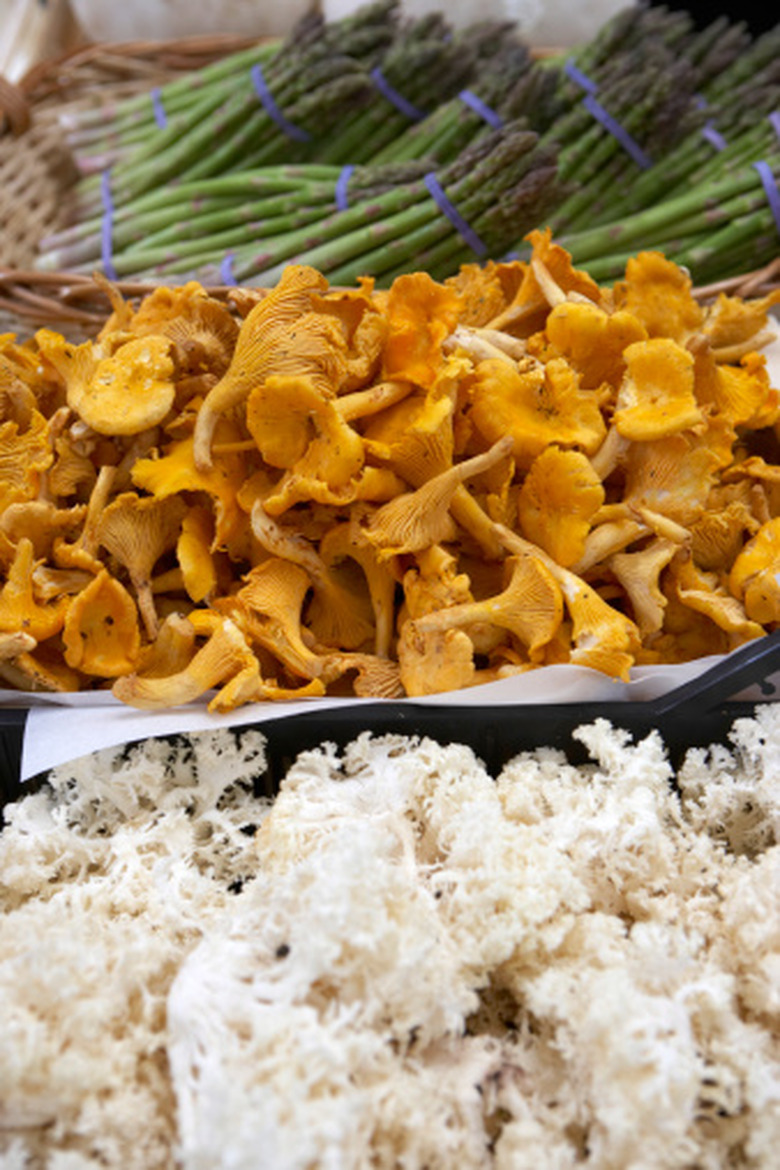Identification Of Wild Mushrooms In Virginia
Mushrooms are the fruiting bodies of fungi, and the state of Virginia has a wide variety of wild mushrooms. Some of these are edible, but many are not – in fact, many are poisonous. When gathering mushrooms in Virginia, correct identification is important to make sure those poisonous and edible mushrooms aren't mixed.
Warning
Always work with an experienced guide when foraging for edible wild mushrooms.
Smooth and Golden Chanterelles
Smooth and Golden Chanterelles
Two of the most popular mushrooms in Virginia are the golden chanterelles (Cantharellus cibarius) and smooth chanterelles (C. lateritius). These colorful, trumpet-shaped mushrooms are identifiable by their yellow or pale yellow "false" gills on their underside. The "gills" are actually ridges that fork off as they near the edge of the cap and have clear cross-veins. Chanterelles have firm, stringy flesh that is described to have a velvety texture and peppery flavor when cooked. When gathering chanterelles, look for scattered groups in leaf litter or among the grass – never on logs or trees.
There are a couple of inedible look-alike species to be aware of such as the Jack-o-Lantern (Omphalotus illudens), which is distinguished by its "true gills" and brighter yellow color. Another look-alike is the false chanterelle (Hygrophoropsis aurantiaca) with similar "gills" to chanterelles; however, they don't have obvious cross-veins, and they are orange. False chanterelles are have thinner flesh and grow on decaying logs.
Black Trumpet Chanterelles
Black Trumpet Chanterelles
Black trumpet chanterelles (Craterellus cornucopioides) look like a dark-brown or black trumpet or vase with wavy edges. They grow in groups among woods and on mossy hillsides in the summer months. Black trumpet's surface usually has a dry, scaly texture. Like the golden chanterelles, black trumpet chanterelles lack "true gills." These ridges are gray when young and turn to a pale pink color as they mature.
Morels
Morels
Morels (Morchella spp.) are the most popular yet hardest to find on this mushroom species list. Morels grow among the leaf litter underneath yellow poplars (Liriodendron tulipifera), elm (Ulmus spp.), oak (Quercus spp.) and ash (Fraxinus spp.) trees. They grow for approximately five weeks in the summer between late March and early May. Morels have a very distinctive appearance, like a conical brain that is hollow on the inside. These mushrooms tend to fruit in bunches on the ground.
When gathering morels, be wary of the poisonous big red false morel (Gyromitra caroliniana). This mushroom has a similar brainlike appearance to the true morels but isn't hollow inside. Its cap is reddish-brown on the outside and tan on the inside with a white stalk.
Giant Puffball
Giant Puffball
The giant puffball (_Calvatia gigantea_) is an edible mushroom that grows up to 20 inches in diameter. As its name suggests, it looks like a giant, globular ball growing on the leaf litter or in fields. Puffballs are pure white all the way through. As the puffball ages, cracks form on the surface, releasing the mushroom's spores.
Oyster Mushrooms
Oyster Mushrooms
Graceful, white or grayish oyster mushrooms (Pleurotus ostreatus) grow in clusters on dead trees, logs and living tree trunks. They have a large, shelf-like fruiting body with narrow gills on their underside. They are identifiable by their short, thick off-center stalks, semi-circular cap and thick, fleshy texture. Oyster mushrooms grow from spring to autumn in Virginia.
Chicken-of-the-Woods
Chicken-of-the-Woods
Chicken-of-the-woods (Laetiporus sulphureus) is a yellow and orange polypore mushroom that grows in bunches on the sides of oak trees. It can be found in Virginia forests from spring until autumn. It gets its name from its flavor – the young mushrooms are said to taste like chicken when cooked.
Amanita Family
Amanita Family
**Mushrooms in the Amanita genus are poisonous and hallucinogenic**. Many look similar to edible varieties of mushrooms in Virginia. Because of the similarities, is important to properly identify mushrooms before eating them. When eating wild mushrooms, always cook them and keep a fresh one from the batch aside for later identification if a stomach upset occurs.
Mushroom Collecting
Mushroom Collecting
Collecting edible wild mushrooms in Virginia is permitted in national parks for personal use only. Knowing which mushrooms are edible is important because collecting medicinal, poisonous or woody shelf mushrooms that grow on the sides of trees is prohibited. Joining a local mushroom club and getting a good field guide will help with identification.
References
- Virginia Wildflowers: Chicken of the Woods
- Virginia Department of Wildlife Resources: It's Time to Gather Summer Mushrooms
- Virginia Department of Wildlife Resources: The Morel: Virginia's Favorite Mushroom
- Virginia Wildflowers: Oyster Mushrooms
- Missouri Department of Conservation: Black Trumpet
- Missouri Department of Conservation: Big Red False Morel
- Australian National Herbarium: The Giant Puffball
- National Parks Service: Shenandoah: Mushrooms and Other Fungi
- Missouri Department of Conservation: Smooth Chanterelle
- National Parks Service: Shenandoah: Collecting Plants and Mushrooms
- Missouri Department of Conservation: Oyster Mushroom
- Missouri Department of Conservations: Chanterelles
- Beaty Biodiversity Museum: Hygrophoropsis Aurantiaca — False Chanterelle
Cite This Article
MLA
Jerrett, Adrianne. "Identification Of Wild Mushrooms In Virginia" sciencing.com, https://www.sciencing.com/identification-of-wild-mushrooms-in-virginia-12432430/. 30 September 2021.
APA
Jerrett, Adrianne. (2021, September 30). Identification Of Wild Mushrooms In Virginia. sciencing.com. Retrieved from https://www.sciencing.com/identification-of-wild-mushrooms-in-virginia-12432430/
Chicago
Jerrett, Adrianne. Identification Of Wild Mushrooms In Virginia last modified March 24, 2022. https://www.sciencing.com/identification-of-wild-mushrooms-in-virginia-12432430/
